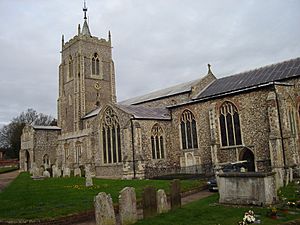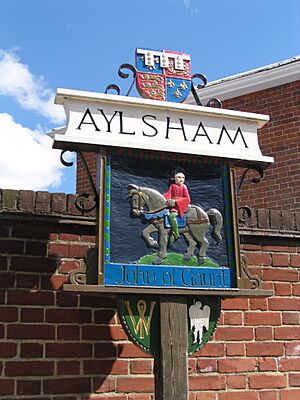Aylsham facts for kids
Quick facts for kids Aylsham |
|
|---|---|
 Church of St Michael and All Angels |
|
| Area | 17.52 km2 (6.76 sq mi) |
| Population | 8,817 (2021) |
| • Density | 503/km2 (1,300/sq mi) |
| OS grid reference | TG1927 |
| Civil parish |
|
| District |
|
| Shire county | |
| Region | |
| Country | England |
| Sovereign state | United Kingdom |
| Post town | NORWICH |
| Postcode district | NR11 |
| Dialling code | 01263 |
| Police | Norfolk |
| Fire | Norfolk |
| Ambulance | East of England |
| EU Parliament | East of England |
| UK Parliament |
|
Aylsham (/ˈeɪlʃəm/ or /ˈeɪlsəm/) is a historic market town and civil parish in north Norfolk, England. It sits on the River Bure, about 9 kilometres (5.6 mi) north of Norwich. The river starts near Melton Constable and flows to Great Yarmouth and the North Sea. After 1779, the river became easier to travel on. This allowed goods like grain, coal, and timber to be brought into town by boat.
Aylsham is close to several large and beautiful country estates. These include Blickling, Felbrigg, Mannington, and Wolterton. These grand houses are popular places for tourists to visit.
The civil parish covers an area of about 17.52 square kilometres (6.77 sq mi). In 2011, about 6,016 people lived here. For local government, Aylsham is part of the Broadland district.
Contents
History of Aylsham

Evidence from archaeological digs shows that people have lived in the Aylsham area since very old times. A large Roman settlement was found just over 3 kilometres (1.9 mi) away in Brampton. This Roman site was a busy industrial area. It made pottery and metal items and traded them across the Roman Empire.
Aylsham is believed to have been started around 500 AD. It was named after an Anglo-Saxon leader called Aegel. So, Aegel's Ham means "Aegel's settlement". The town is mentioned in the Domesday Book of 1086. Back then, it had about 1,000 people.
For a long time, until the 1400s, making linen and worsted cloth was very important here. Cloth from Aylsham was even sent to the palaces of kings Edward II and III.
John of Gaunt, a very powerful lord, became the owner of Aylsham in 1372. Aylsham then became the main town for his lands, called the Duchy of Lancaster. Even though John of Gaunt probably never visited Aylsham, the people living there got special benefits. They didn't have to serve on juries outside the area. They also didn't have to pay certain taxes. The town's sign shows a picture of John of Gaunt.
In 1519, King Henry VIII allowed Aylsham to have a market every Saturday. He also allowed an annual fair on March 12th. Aylsham's markets have always been a big part of the town. Many businesses grew to serve the town and the farms around it. Besides weekly markets, there were also cattle fairs twice a year. In October, there was a fair where people could find work.
The old Black Boys Inn in the Market Place is one of Aylsham's oldest buildings. It has been there since the 1650s. The front of the building you see today was built between 1710 and 1720. This inn was a stop for the post coach from Norwich to Cromer. It had stables for 40 horses and employed many workers.
A special thatched water pump was built in 1911. It was made in memory of John Soame by his rich uncle. This pump gets water from 52 metres (171 ft) deep underground. Its roof is made of Norfolk reed.
Like many other market towns, Aylsham became rich from making cloth in the medieval period. At first, making linen was most important. Aylsham linens were famous across the country. After the 1500s, linen making became less important. Making wool cloth then became more popular. This continued until the Industrial Revolution. After that, the main trade in the 1800s was grain and timber. The town also had many other businesses to support local farming. Aylsham has had markets and fairs since at least the 1200s. These weekly and yearly events were very important for trade. Horse fairs brought many traders to town. The weekly market was for more local trade. The rights of market stallholders today come from rules made in medieval times.
Parish Church
The parish church of St Michael and All Angels stands tall in the Market Place. Its tower is a great example of Gothic architecture. The small spire on top of the 30-metre (98 ft) tower can be seen from far away. The main parts of the church were built in the 1200s. The tower was added in the 1300s. The north side of the church was built around 1380, helped by John of Gaunt. Some parts of the old screen inside the church survived.
Transport
Roads
Roads were very important for Aylsham. It was a main stop for coaches on the road between Norwich and Cromer. Coaches from Cromer and Holt would stop at the Black Boys Inn. Coaching ended when railways arrived in the 1880s.
Today, the town is on the A140 road. This road goes between Ipswich and Cromer, passing through Norwich.
Buses
Aylsham has regular bus services to Norwich and Sheringham. These are run by Sanders Coaches. Some buses also go to Cromer and Sheringham. Other services connect to nearby villages and towns. These include Wroxham, East Dereham, North Walsham, and Felbrigg.
Railways
Aylsham once had two railway lines and two stations. Aylsham South was on a line that went between County School and Wroxham. Aylsham North was on a line from Melton Constable to Yarmouth. Both stations closed in the 1950s.
Today, Aylsham railway station is the start of the Bure Valley Railway. This railway was built in 1990 on the site of Aylsham South station. It is a small, 15-inch (38 cm) gauge heritage railway. It runs for 14 kilometres (8.7 mi) to Wroxham. It is Norfolk's longest railway with a narrow track.
Several long walking paths that follow old railway lines start or pass through Aylsham:
- The Bure Valley Path runs next to the Bure Valley Railway from Aylsham to Wroxham.
- Marriott's Way follows an old railway track from Aylsham to Norwich.
- Weaver's Way starts in Cromer and much of it follows an old railway line to Yarmouth.
Waterways
The River Bure was a natural way to transport goods for Aylsham. However, it was not easy for large boats to use. In the 1700s, there was a plan to make the river wider from Coltishall to Aylsham. After many problems, trading boats called wherries from Great Yarmouth could reach a special dock in Aylsham. This river transport ended because of a big flood in 1912.
Media
Local news and TV shows for Aylsham come from BBC East and ITV Anglia. You can listen to local radio stations like BBC Radio Norfolk and Heart East. The local newspaper is the Eastern Daily Press.
Aylsham Today
In 2005, Aylsham won a Silver Award in an international competition. This competition celebrated towns that are great places to live. It was called the International Awards for Liveable Communities.
Aylsham is also one of the first towns in Norfolk to join the Cittaslow movement. This is an international group that promotes "Slow Towns". These are towns where the Quality of Life is very important. People say Aylsham didn't need to change much to join. It was already a good example of a "Slow Town".
Local entertainment in Aylsham includes concerts by the Aylsham Band. The Aylsham Players put on plays once or twice a year. Aylsham High School also performs a musical every year.
Aylsham is on the Weaver's Way walking path. This path goes past Blickling Hall. Blickling Hall is a beautiful country house looked after by the National Trust. It is about 2 kilometres (1.2 mi) from Aylsham. Blickling Hall is a great example of a Jacobean brick house. It was once the home of a young Anne Boleyn.
The yearly Aylsham Show features farm exhibits. It happens on the August bank holiday Monday at nearby Blickling Park.
The Aylsham Heritage Centre is in an old Victorian building near St. Michael's Church. You can use the records there to learn about the town's past.
The Tesco store in Aylsham opened in July 2008. It was built using wood, recyclable plastic, and other materials that are good for the environment. It claimed to be the "greenest in the world" at the time.
Notable Residents
Thomas Hudson, who made gloves in Aylsham, was one of the Protestant martyrs. He was put to death for his beliefs during the time of Queen Mary. He was burned at the stake in Norwich in 1558.
Sir Jerome Alexander (died 1670) was a judge in Ireland. He was known for being very strict. He went to school in Aylsham around 1600.
Daniel Defoe, a famous writer, is thought to have stayed in Aylsham in 1723. He was traveling through eastern England and enjoyed a meal at the Black Boys Inn. Parson Woodforde, a famous diarist, also ate there in 1781. It is said that Horatio Nelson, a famous admiral, danced in the Assembly Room at the inn. His cousin lived in Aylsham.
Humphry Repton (1752–1818) was a landscape gardener. He lived nearby and is buried in St Michael's Churchyard. His paintings show what the Market Place looked like in the early 1800s.
The Reverend James Bulwer (1794-1879) was born in Aylsham. He was a collector, naturalist, artist, and studied shells.
Kathleen Starling (1890–around 1970) became an opera singer known as Kathleen Destournel. She sang at Covent Garden and performed for soldiers during the Second World War. She later lived in Arizona, USA, and then returned to Aylsham.
Clive Payne (born 1950) was a professional footballer. He played for Norwich City and AFC Bournemouth. He was born in Aylsham.
Nick Youngs (born 1959) and his two sons, Ben (born 1989) and Tom Youngs (born 1987), grew up near Aylsham on their father's farm. Nick Youngs was a rugby union player for Leicester and England. Both of his sons also played for the national rugby union team. The Youngs brothers gave land for a new sports ground to be built in the town.
Gallery
-
Black Boys Inn
Twinning
Aylsham is twinned with
- La Chaussée-Saint-Victor, Loir-et-Cher, France
It also used to have a friendly connection with
- Aylsham, Saskatchewan, Canada
See also
 In Spanish: Aylsham para niños
In Spanish: Aylsham para niños






